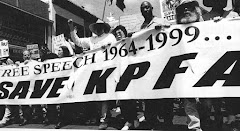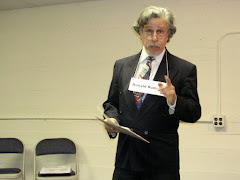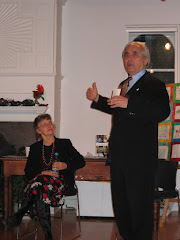This is the fourteenth chapter of a series excerpted from “Maverick
Chronicles,” a memoir-in-progress. Previous
stories can be found at VTDigger. By Greg Guma
Visiting Nicaragua as part of a peace delegation in 1983 was an inspiring
experience. But I also noticed that the Sandinista road had some potholes. In bookstores,
for instance, I saw only Marxist literature and imports from the Soviet Union.
The country’s literacy crusade had made a huge difference, but right-wing
propaganda was being replaced by ham-handed left-wing indoctrination.
 |
| Paulo Freire teaches |
But how is knowledge created? I had asked.
“Knowledge is a mixture of thought and action which becomes like a ball
in permanent motion,” he said. “It moves in spirals until the 'teachment' comes
forth and knowledge appears."
The process sounded a bit like giving birth, a painful but liberating
experience. Knowing demands reflection, action, curiosity, patience, hope to
create and taking risks, Freire explained. But in most schools, the acts of knowing
and creating new knowledge are divided, so places of education have essentially
become shopping centers that sell existing knowledge.
"In Latin America fatalism is expressed in reliance on God,” he
said. “In North America it is the power of the establishment and technology
that replaces God. It is as though history is already finished and not being
created and growing."
When I shared my impressions of Nicaragua during a speaking tour, some people
in audiences nevertheless objected to my questions about the Sandinistas’
decision to suppress dissent or censor books and newspapers. They have no
choice, folks said, pointing to US attempts to overthrown the new regime. They
were right. The Reagan administration was funding a violent insurgency and
other forms of destabilization. But the Sandinistas weren’t perfect, and support
for them need not exclude a bit of constructive criticism.
Self-criticism was supposedly an aspect of the Left’s approach to
process. When it came to “our side,” however, any break from “unity” could be grounds for a charge of disloyalty, perhaps even “collaboration” with the
enemy.
Frustrated with such reactions, I stopped speaking about politics in
public for a while and returned to the book business to launch Maverick
Bookstore and Gallery in Burlington’s Old North End. The name felt appropriate, philosophically and because the Lloyds, my son’s family on Robin’s side,
were related to the Maverick clan in Texas.
Samuel Maverick was a big Texas personality and the origin of the
word’s modern usage. The official story is that he won a ranch in a card game
and afterward declined to brand his steers. Unbranded steers became known around
San Antonio as mavericks.
The TV show Maverick was pure fiction, but there was a large
maverick family. Robin’s grandfather married Lola Maverick. He became famous briefly
as a so-called “Communist millionaire;” she helped organize the Ford Peace Ship
before World War I and co-founded the Women’s International League for Peace
and Freedom. Some of their children were activists as well, including Robin’s dad
Bill. So, when I thought about an independent enterprise, not to mention my journalism
and peace work, the name felt apt.
Running a local business replaced political arguments with community
service, brought in a modest income, and provided the opportunity to create an
outlet for new community projects. But I was still restless, and spent considerable
time over the next several years in Europe, seeing as much of the world as I
could afford.
At the end of the 1980s I tried to reconnect with Vermont as
coordinator of the Burlington Peace and Justice Center and commissioner on the
local Library Board. I even made a second run for the City Council, again
getting 42 percent of the vote. In that race the local GOP Chair called me a
“serious professional revolutionary anarchist,” an attack I turned into a
campaign button. But despite some modest successes – forging a connection
between the peace and environmental movements, publishing a book about Vermont, bringing the local library under direct city control – I felt disconnected, out of synch with the
increasingly gentrified Burlington scene.
 |
| One of our Mexican campsites |
Before arriving we were both offered jobs, she as a music therapist at
a state hospital, me as manager of a bookstore in Santa Monica. Gail Stevenson,
a successful therapist with celebrity clients and a Frazier Crane-like husband
who offered advice on the radio, was about to open a trendy “eco-feminist”
bookstore across from the Santa Monica Museum. She’d heard about my Vermont business and hoped to create something similar, a bookstore that was also a center
for community activity. She already had a name – Revolution.
The location was prime, the patrons affluent, sometimes famous, the
space large and airy. But Gail was more concerned about what it looked like
than how well it functioned as a business. The interior was designed by an
architect partial to deconstructionist style, so books were piled on rough
crates and lodged on stark metal shelves that made effective display difficult.
Six months after the opening, an event heralded by a front page piece in the
style section of the Los Angeles Times, the renovations still weren’t complete.
No matter how much money we made it wasn’t enough. The main reason was
Gail’s inability to stop spending on anything but books. The kid’s section had
to be a posh playground with toys and designer pillows, the coffee bar had to
feature only the best espresso machine and pastries. There were always more ads
to place for events, and new ideas for an even better image. Meanwhile, I
struggled to make payroll for a large seven-days-a-week staff and keep up with
monster bills from our wholesalers.
When I mentioned the problems to Gail, pleading with her to get a grip
on the spending, her gaze would drift away, as if distracted by an invisible
marvel somewhere in the distance. When I finished talking she’d turn back and say
something like, “We need better biscottis.” It was maddening.
Eventually, I demanded some changes. Making a comprehensive list of
what was essential to get the operation into the black, I presented my case. The
next day she introduced my replacement.
Two weeks later I was unemployed. Three weeks after that I received a
call from a member of the bookstore staff. On Gail’s 46th birthday, the staffer
recounted, she had purchased a gun, learned how to use it at a shooting range,
then driven to her Westwood office and killed herself. She was beautiful, blonde
and wealthy, with a young son, an admired spouse and A-list friends. None of it
turned out to enough.
I stayed in L.A. for another year, but after the Revolution disaster I just couldn’t
connect with the city’s ephemeral, often narcissistic culture. Three of my
screenplays made the rounds – an historical epic on the Haymarket bombing, a
film noir take on the CIA’s notorious MK-Ultra mind control program and a
contemporary thriller about religious fundamentalists who carry out
assassinations for a covert right wing group – but none of them survived the
Hollywood meat grinder. After a few years neither did my marriage, although my
love never faded and the memories remain.
Back in Vermont, the editorship of Toward Freedom opened up at the right
moment, so I returned East and tried to recover. Still, the restlessness
would not go away.
In 1995, when an ex-girlfriend got in touch and I learned that she was
moving to New Mexico for health reasons, I decided to give the west another
try. Fortunately, the Internet had gone public by then, so it was possible to
edit Toward Freedom long distance, even increase its immediacy and writer network.
Dave Dellinger, who was co-chairing the board with Robin Lloyd, was skeptical
but willing to give the idea a chance.
A few months after arriving I was both editing TF and running yet
another progressive non-profit, the Albuquerque Border City Project, an
immigrant rights organization that provided legal services. As it happened, the
US was just entering one of its periodic bouts with anti-immigrant fever.
While living in L.A., I had watched the Border Patrol play a key role
in the riots of 1992, deployed in Latino communities and arresting more than
1,000 people. Afterward, the INS had begun work with the Pentagon’s Center for
Low-Intensity Conflict. The line between civilian and military operations was
largely being erased. Human Rights Watch accused the US Border Patrol of
routinely abusing people, citing a pattern of beatings, shootings, rapes, and
deaths. In response, INS detainees in a private jail rioted in June 1995 after
being tortured by guards.
In many ways Los Angeles embodied the American Dream. The confluence of
climate, capital and demographics had made California one of the world’s largest economies,
an “international” state that was also the image capital of the world. But it was
also rapidly becoming a "third world" state. As David Rieff
noted in Los Angeles: Capital of the Third World, the rest of the country – and
perhaps the world – might well follow the L.A. model. Rieff considered it, at the very
least, a national archetype. The US was no longer an extension of Europe, he
argued, becoming instead "an increasingly nonwhite country adrift,
however majestically and powerfully, in an increasingly nonwhite world."
While I worked in Albuquerque, the border became a battlefield, and
government strategies for combating undocumented immigration re-militarized the
region. The recently-passed North American Free Trade Agreement (NAFTA) meshed
neatly with more obvious aspects of low-intensity conflict (LIC) doctrine. The
definition of immigration and drug trafficking as “national security” issues
brought state-of-the-art military approaches into domestic affairs. Just as the
projection of a “communist menace” was a smokescreen for post-war expansionism,
a “Brown wave,” the “Drug War” and terrorism were being used as pretexts for
military-industrial penetration.
In New Mexico I immersed myself in immigration law and regional race
politics, developing a coalition of sympathetic groups to fight back against
the most draconian aspects of a new immigration reform law. We staged public rallies
in Old Town, and brought Latino and Asian spokesmen to Santa Fe to testify at legislative
hearings. Sensing potential, the progressive power structure welcomed such initiatives
and offered me a spot on the State Human Rights Commission.
I remained an outsider, however, one who didn’t fully understand the nature
of the local culture or embrace some of its assumptions. The cause was just.
But the small, progressive enclave I’d entered was isolated from a larger
and essentially conservative community. Neither felt like a place where I could
comfortably put down roots.
What was I, an activist or a writer? A foot soldier in the long
progressive march – a movement about which I was having some doubts – or a social
critic and observer, always questioning conventional wisdom? Was it possible to
be both? Wherever I went such questions followed.
Maybe my standards were too rigid, or my expectations too high, I
thought. Maybe a more practical, less perfectionist approach to life and work
would serve me – and whatever came next – a bit better. After years of
self-imposed exile it was time to go home and find out.
Maverick Chronicles will continue ...
































No comments:
Post a Comment